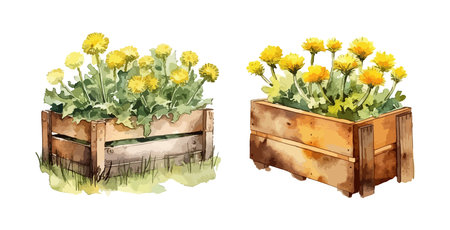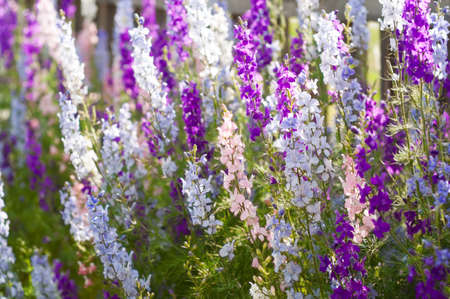Introduction to Perennials in the UK
Perennial plants form the backbone of British gardens, providing structure, colour, and resilience year after year. Unlike annuals, which complete their life cycle within a single season, perennials return each spring, offering long-term value and reducing the need for frequent replanting. The temperate and often damp British climate is particularly well-suited to a wide range of perennial species, allowing them to thrive with relatively minimal intervention. This natural compatibility has shaped local gardening traditions for generations, with classic English borders, cottage gardens, and herbaceous displays all relying heavily on robust perennial varieties. For gardeners in the UK, choosing perennials is not only practical but also connects them to a rich horticultural heritage that prizes reliability, sustainability, and seasonal beauty.
Top Performing Perennial Varieties for the British Climate
When selecting perennials for gardens across the UK, it is essential to consider varieties that are not only visually appealing but also hardy and low-maintenance. The unpredictable British weather demands plants that can thrive in varying conditions, from damp winters to occasional summer droughts. Below is a selection of reliable perennial species, recommended for their resilience, ease of care, and consistent performance in gardens throughout England, Scotland, Wales, and Northern Ireland.
Reliable Perennial Choices for UK Gardens
| Perennial Variety | Hardiness | Main Flowering Period | Key Benefits |
|---|---|---|---|
| Geranium (Cranesbill) | Very hardy (H7) | Late spring to autumn | Long flowering, tolerates shade, minimal maintenance |
| Hemerocallis (Daylily) | Hardy (H6-H7) | Early to late summer | Drought tolerant once established, pest resistant |
| Astrantia (Masterwort) | Hardy (H7) | Early summer to late summer | Copes with damp soils, attractive to pollinators |
| Echinacea (Coneflower) | Hardy (H5-H6) | Midsummer to early autumn | Drought tolerant, supports wildlife |
| Alchemilla mollis (Lady’s Mantle) | Very hardy (H7) | Late spring to mid-summer | Tolerates poor soils, attractive foliage and flowers |
| Sedum (Stonecrop) | Hardy (H6-H7) | Late summer to autumn | Drought resistant, good for pollinators, neat habit |
| Pulmonaria (Lungwort) | Very hardy (H7) | Early spring to late spring | Tolerates shade and moist soils, decorative leaves |
| Heuchera (Coral Bells) | Hardy (H6-H7) | Late spring to early summer | Evergreen foliage, shade tolerant, easy care |
| Lupinus (Lupin) | Hardy (H5-H6) | Late spring to early summer | Spectacular flower spikes, attracts bees |
| Achillea (Yarrow) | Hardy (H6-H7) | Midsummer to early autumn | Drought tolerant, long-lasting blooms, wildlife friendly |
Cultural Considerations for Selection Across the UK Regions
The above list includes perennials known for their adaptability across different regions of the UK. For northern or more exposed sites in Scotland and northern England, choose those with the highest hardiness ratings (H7). In milder southern regions or coastal areas, all listed varieties should perform reliably with minimal intervention. For best results, match your plant selection with local soil types—many perennials like Geranium and Pulmonaria tolerate heavy clay or damp conditions common in Britain.
By focusing on these proven perennial varieties and considering their specific requirements for light and moisture, you can ensure a vibrant and resilient garden display throughout the seasons.

3. Site Selection and Soil Preparation
Proper site selection and soil preparation are fundamental steps for establishing thriving perennials in the British climate. By assessing your garden’s unique conditions and making necessary amendments, you can ensure that your chosen plants reach their full potential.
Best Practices for Choosing Planting Locations
Start by observing your garden’s microclimates. Many perennials flourish in areas with good air circulation and shelter from harsh winds, which are common across the UK. South or west-facing borders often provide optimal sunlight, while east-facing sites may suit shade-tolerant varieties. Consider existing features such as trees, walls, and fences, as these can impact both light levels and exposure to the elements.
Assessing Light and Drainage
Light is a crucial factor in perennial performance. Use the RHS guidelines to determine whether your chosen spot offers full sun (at least six hours of direct sunlight), partial shade, or full shade. In terms of drainage, most perennials prefer well-drained soils to prevent root rot. Test your soil after rainfall: if water lingers for more than an hour, consider improving drainage by incorporating organic matter or creating raised beds. Avoid low-lying areas prone to waterlogging, especially in regions with heavy clay soils typical of many British gardens.
Preparing Typical British Soils
The UK features a range of soil types, from sandy loam in East Anglia to heavy clay in the Midlands and North. Regardless of type, most British soils benefit from regular improvement. Begin by removing perennial weeds and breaking up compacted ground. Dig in plenty of well-rotted compost or manure to enhance fertility and structure. For clay soils, add horticultural grit or sand to aid drainage; for sandy soils, increase moisture retention with additional organic matter. Always test soil pH—most perennials thrive in neutral to slightly acidic conditions (pH 6–7), though some, like heathers, prefer more acidic environments.
Additional Tips for Success
Consider mulching with bark or leaf mould after planting to suppress weeds and conserve moisture—a particularly useful practice during unpredictable British summers. Monitor new plantings closely during their first year, ensuring they receive adequate water during dry spells but are not left standing in soggy soil. With careful site selection and thorough preparation, your perennial borders will become resilient and rewarding features of your British garden.
4. Planting and Establishment Advice
When establishing perennials in the UK, timing and technique are crucial for long-term success. The optimal planting seasons are spring (March to May) and early autumn (September to October), when soil temperatures are favourable and moisture levels support root development.
Planting Steps and Spacing Guidelines
Proper spacing is essential to prevent overcrowding, which can lead to poor air circulation and increased risk of disease. Refer to the table below for recommended spacing based on common perennial types:
| Perennial Type | Recommended Spacing |
|---|---|
| Herbaceous Perennials (e.g., Geranium, Hosta) | 30–45 cm apart |
| Tall Perennials (e.g., Delphinium, Lupin) | 45–60 cm apart |
| Ground Cover Perennials (e.g., Alchemilla mollis, Ajuga) | 20–30 cm apart |
How to Plant Perennials Properly
- Prepare the Soil: Loosen the soil to a depth of 30 cm, incorporating well-rotted compost or manure for added fertility.
- Check Root Health: Gently tease out any circling roots before planting.
- Plant at Correct Depth: Ensure the crown is level with the soil surface; avoid planting too deep or shallow.
- Firm In and Water Well: Press soil around roots firmly and water thoroughly after planting.
Initial Aftercare Tips
- Watering: Keep newly planted perennials consistently moist during their first growing season, especially during dry spells.
- Mulching: Apply a 5–8 cm layer of organic mulch around plants to conserve moisture, suppress weeds, and regulate soil temperature.
- Protection: Shield young plants from late frosts using horticultural fleece if necessary in spring or autumn.
- Monitoring: Check regularly for signs of pests or diseases and address promptly to ensure robust establishment.
The key to successful perennial establishment in the British climate lies in careful timing, correct planting techniques, and attentive aftercare—laying a strong foundation for years of reliable garden performance.
5. Ongoing Care and Seasonal Maintenance
To ensure your perennials thrive year after year in the British climate, it is essential to adopt a comprehensive maintenance routine that addresses the unique challenges of each season. Below are key strategies tailored to UK gardens:
Mulching for Moisture Retention and Weed Control
Applying a generous layer of organic mulch, such as well-rotted compost or bark chips, in spring helps retain soil moisture during drier spells and suppresses weeds. Mulching also insulates roots against sudden temperature fluctuations, which are common in the British Isles.
Dividing Established Perennials
Many perennials benefit from division every three to five years. This process rejuvenates overcrowded clumps, encourages more vigorous flowering, and prevents disease build-up. The ideal time for division depends on the species: spring-flowering plants are best divided in autumn, while late-summer bloomers can be divided in early spring.
Pruning and Deadheading Techniques
Regular pruning maintains plant shape and promotes healthy new growth. Deadheading—removing spent flowers—prolongs blooming periods and redirects energy into root development. In late autumn, cut back faded stems, but consider leaving some seed heads for winter interest and wildlife support.
Winter Protection Strategies
The unpredictable British winter can bring frost, wet conditions, or mild spells. Protect tender perennials by covering crowns with straw or horticultural fleece and ensure containers are raised off cold ground to prevent waterlogging. Remove excess mulch in early spring to avoid encouraging rot as temperatures rise.
Consistent Observation and Adaptation
Finally, regular monitoring allows you to spot issues early—such as signs of disease or pest damage—and adapt care routines accordingly. By combining these proactive maintenance techniques, you’ll foster resilient perennial borders that flourish whatever the British weather brings.
6. Dealing with Common Pests and Problems
Identifying Typical British Garden Pests
When cultivating perennials in the UK, gardeners frequently encounter a range of common pests and challenges unique to the British climate. Slugs and snails are perhaps the most notorious adversaries, especially during damp springs and autumns. These molluscs are drawn to young shoots and foliage, often leaving unsightly holes and ragged edges in their wake. Other potential issues include aphids, vine weevils, and fungal diseases exacerbated by periods of high humidity or prolonged wet weather.
Managing Slugs and Snails Effectively
To protect your perennials, employ a combination of cultural, physical, and biological controls. Start by removing debris and excess mulch where slugs and snails may shelter. Barriers such as copper tape or crushed eggshells can deter these pests from reaching vulnerable plants. For persistent infestations, consider using wildlife-friendly slug pellets or encouraging natural predators like hedgehogs, frogs, and birds into your garden.
Tackling Climatic Stressors
The unpredictable British weather — including late frosts, heavy rainfall, and dry spells — can stress perennial plants. To mitigate these effects, choose resilient varieties well-suited to your local conditions. Mulching in spring helps conserve soil moisture during dry periods while also suppressing weeds. During wet spells, ensure adequate drainage to prevent root rot; raised beds or adding grit to planting holes can be beneficial.
Regular Monitoring and Maintenance
Vigilance is key to maintaining healthy perennials. Inspect your plants regularly for early signs of pest damage or disease, such as discoloured leaves, wilting, or stunted growth. Promptly remove affected plant material to prevent problems from spreading. Practising good garden hygiene — including cleaning tools between uses — further reduces risks.
Integrated Pest Management for Long-Term Success
Adopting an integrated approach that combines prevention, observation, and targeted intervention is the most effective way to protect your perennial garden in the British climate. By staying proactive and responsive to changing conditions, you’ll ensure your borders remain vibrant and healthy throughout the seasons.


